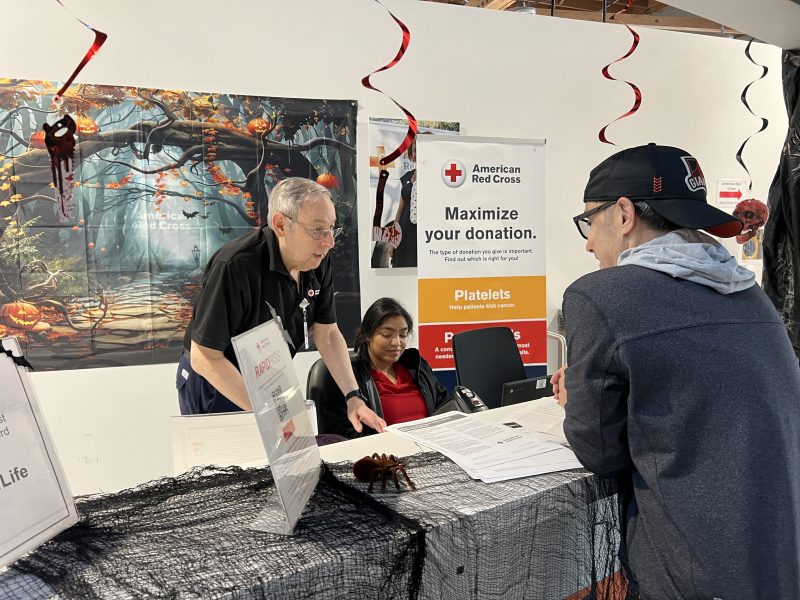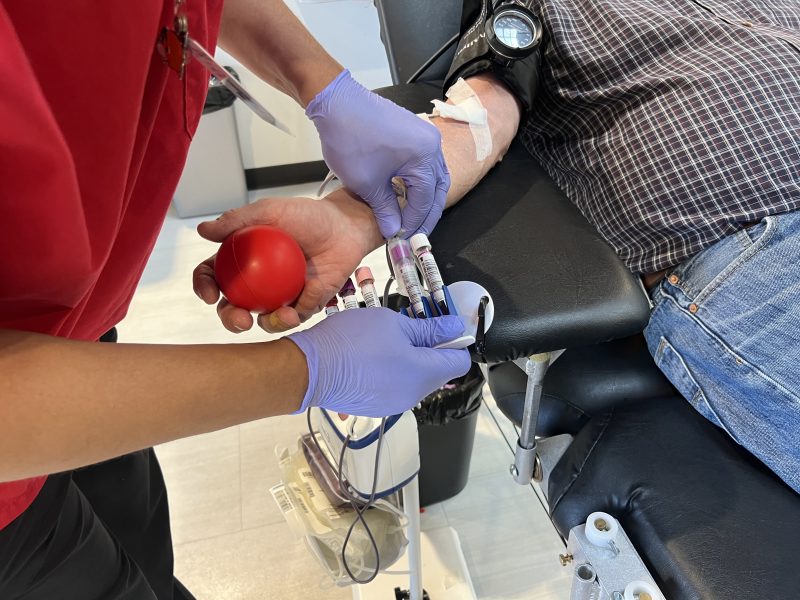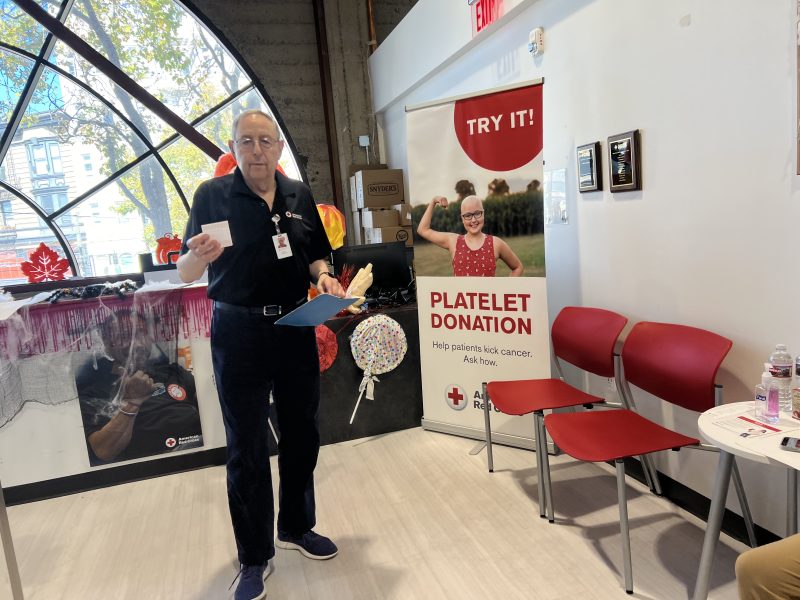Retiree wants your blood: Donor Ambassador devotes his all to Red Cross collection efforts
Mark Sugarman wants to repair the world. The 79-year-old Financial District resident has spent his whole life following that maxim, which in Hebrew is known as Tikkun Olam.
He does that through volunteering, which he refers to as “my job.” His latest focus is on the Red Cross’s Market Street branch, where he volunteers each week as a Donor Ambassador. Sugarman said he has no hobbies other than going to the gym, where he exercises six days a week.

When he’s not exercising or volunteering, he wears a Red Cross T-shirt. “I’m always asking people, ‘Have you ever given blood, and do you want to give blood?’” This volunteer job is especially important, he said, because while 68 percent of people are actually eligible to give blood, only three percent actually give it.”
And he’s not just looking for one-time donors. “What I am trying to do is get people consistent in giving blood.” He admits most of what he does as Donor Ambassador involves talking.
That starts the moment someone walks in the door until they are finished donating. “The Jewish word is schmoozing – small talk,” he said. “So that when they come in this will be a good experience. I will sit with them in the café area to determine how they are, how they feel.”
A one-on-one personality
It was the opportunity to work directly with donors that attracted Sugarman to the Red Cross. “Basically, what I like doing, what I’ve always liked doing is interacting with people. My personality fits well with the one-on-one.”

Sugarman worked for most of his life in the paper distribution industry, forming his own business as a headhunter in the field in 2001. He retired in 2016. He has a Bachelor of Science in Economics from the University of Pennsylvania’s Wharton Business School and a Master of Business Administration from Columbia University. Sugarman was in the U.S. Army Reserves during the Vietnam era.
His partner of 23 years, Terry Kraus, works part-time in membership at Congregation Emanu-El, where Sugarman attends worship services every Saturday. He has two children: Karen, a licensed social worker at Stanford, and Jeffrey, a public defender in New York City. He also has an identical twin brother, James, who lives in Connecticut. James also worked in the paper distribution industry, but their careers followed different tracks.
When a donor arrives at the Red Cross, Sugarman gets their ID, then creates a folder with their name on it and the type of donation they’re going to make. Then a phlebotomist picks up the file and takes blood from the donor. The whole process takes about an hour.
It’s important that Sugarman stick around even after the donation is made. “After you give blood or platelets, it’s a state law that you must sit for 15 minutes. People react differently to giving blood. Sometimes after they come into the café area, people become light-headed or nauseous.”
If that happens, he calls over a phlebotomist who may apply cold compresses or have the person lie down.

There are three types of donations: regular blood, red blood cells, and platelets. Regular blood donation can be done only once every two months. It’s good for use for 42 days. Platelets, which are used as a clotting factor in cancer treatments and emergency rooms can be given every five days. That takes two and a half hours as blood is removed from the donor, platelets are collected, and the blood is then returned to the body through a tube in the other arm. Platelets have a shelf life of only five days.
Sickle cell challenges
The screening process for blood and platelets still has high standards although some have been relaxed in recent years. Prior to each donation, a phlebotomist asks donors 26 health questions to determine if they are eligible. “Deferrals include taking antibiotics the day of the donation, traveling to countries where there’s malaria, or, if you’ve just traveled to India, you can’t give for three years,” Sugarman said. There are also restrictions after travel to Bali or Thailand.
For many years, people who lived in Britain during the 1980s were prevented from giving blood because of the prevalence of mad cow disease. That restriction, said Sugarman, has now been lifted.
And restrictions on the gay community were recently lifted, except for those with a new partner within the previous three months if they engaged in anal sex.
One of the biggest challenges facing the Red Cross is collecting enough blood for African Americans with sickle cell disease. Blood suitable for those with the genetic disease is found more frequently in the Black community than in the general population. But only one in three African American donors fall into this category
“It’s very possible that someone with sickle cell who needs a transfusion can’t get it because it simply isn’t available,” said Sugarman.
Sickle cell disease affects one out of every 365 Black or African American births and people with it may need as many as 100 units of blood each year, according to the Red Cross. For that reason, the Red Cross in San Francisco has one employee whose entire job is to recruit African Americans to donate blood.
The ups and downs
Sugarman said his emotional reaction to his volunteer work as a Donor Ambassador runs the gamut. “It’s a whole range of emotions. If I walk in and the sheet is full (of names of people who want to donate,) my first feeling is “Great, that’s wonderful,” and if I walk in and there are not a lot of donors that’s terrible. I’m down.”

Sugarman said he’s really encouraged if someone agrees to donate platelets after a blood donation. But that doesn’t always work out, especially if they have tiny, inaccessible veins.
“I had a woman come in, she was African American and had never given blood before,” Sugarman said. “She was really jazzed, and I’m thinking here’s a woman that can give blood, give blood that can help African Americans, and she can give us platelets. And then she goes in and guess what? She has terrible veins, and she can’t give blood at all. I am not depressed but I am disappointed.”
Instead of getting paid for all his efforts, he donates money regularly, noting the Red Cross is mostly made up of volunteers, even in its disaster relief efforts. He cannot donate blood himself because he takes blood thinners. But, he also volunteers at Kaiser Permanente and the Job Forum, helping others secure employment.
For now, the Red Cross remains a priority.
“For me personally, I wouldn’t call it an obsession, because that’s too strong a word, but this has become a very, very large focus for me –trying to build the blood supply.
“I do a lot of volunteer stuff, this whole concept of helping others is very important, and the Red Cross is certainly (doing that).”





